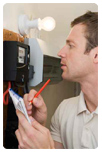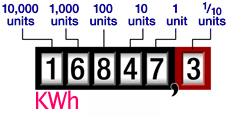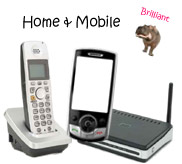 |
||||||
 |
||||||
 |
||||||
|
|
|
|
|
|
|
|
How to check & read your Electric meter.The electricity meters measures the amount of electrical power your home uses. Your electricity comes into your home through the meter before connecting to your homes fuse box and distribution board connecting all your homes mains wiring. Every time you use an electric appliance, turn on the lights, watch tv or boil the kettle, electrical power is consumed. The amount of electricity used is recorded on your electricity meter which is normally located near the entrance to your home, or hallway, or understairs cubboard. It is worth knowing that most energy bills are only estimated ( marked with an "E" on your utility bill). Some regional energy suppliers do employ independent meter readers to carry out reading on their behalf.
The first thing to do is identify what kind of meter you have installed in your home. There are three types of meter in use in the UK. They will either have dial faces, analog digit displays or a digital LCD displays. All meters are read from the left to right. Single rate digital meters: These are simple to read, simply write down the digits in the digital LCD dispay reading from left to right, ignoring the last number marked 0.1 Single rate analog meter: This meter will have one display either as a row of dial faces or as analog digit display. Your electricity will be billed as one tarif for the KWh's your household has consumed.
Economy 7 meters: Economy 7 has two tarifs one for Low (Night time) and one for Normal (Day time). You will find an Economy 7 meter will have two displays or sets of dials. One is marked "low" for your 'night time' energy, and the other set of dials are marked "Normal" for the 'day time' energy consumed. Economy 7 takes advantage of the lower tarif for night time electric use such as Economy 7 heating. When reading the Economy7 meter always write down the reading of both rows of displays. This will let you know how many units you have used in both Low and Normal energy units. Also note that if you are calculating the amount of units you have used between two dates, be sure to subtract or add only "Low" to "Low" reading and "high" to "high" readings. Reading a 'dials' style electric meterYour electrical energy consumed by your household is measured in Kilowatt-hours or kilowatts of power mutiplied by total hours consumed. For example if you turn on a 3 kilowatt rated electric fire at for 2 hours then that appliance would of consumed 2hrs x 3Kws of energy. Ie 6 KWh. The first thing to look for when reading a dial type meter, is that the dials go around in opporsite directions to each other. The arrows on the diagram above illustrate this however this may be different to your own meter. The First dial on the left the needle has just passed number 4. Write down the number that the needle has just passed. This may not always be the number the needle is nearest. The final dial is ignored as it is there for testing and calibration. The light pink shading on the numbers shows which number to write down. Note the second dial the needle is directly over the 5 digit so we note down 5 and not 4 at this point. Our reading is 4 5 9 2 8 . Units (kWh) In this reading one of the numbers is followed by a 9 so the reading will need to be adjusted. To do this reduce the number before the 9 digit by 1. The adjusted and correct reading is hence 4 4 9 2 8 . Units (kWh) You should find your energy supplier will allow you to provide your own meter readings over the phone, by post or through their website. Check the accuracy of your bill against your meter readings, you may be able to save money simply by providing an upto date electric meter reading. You many also want to take your gas meter readings
|








